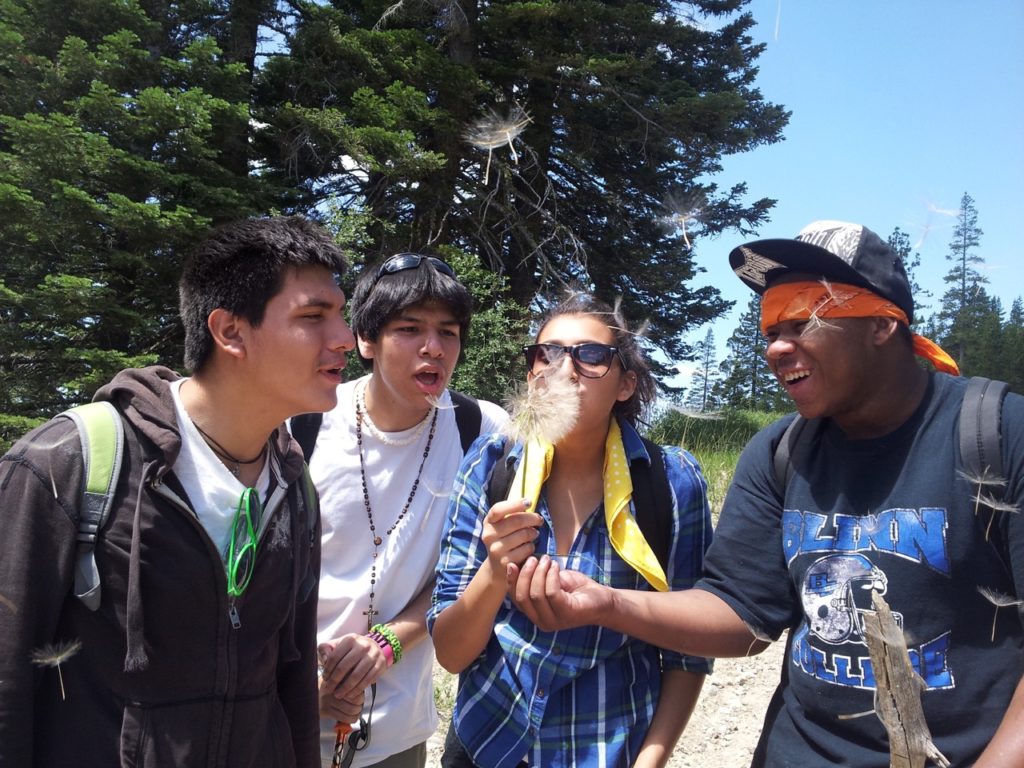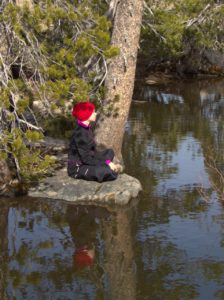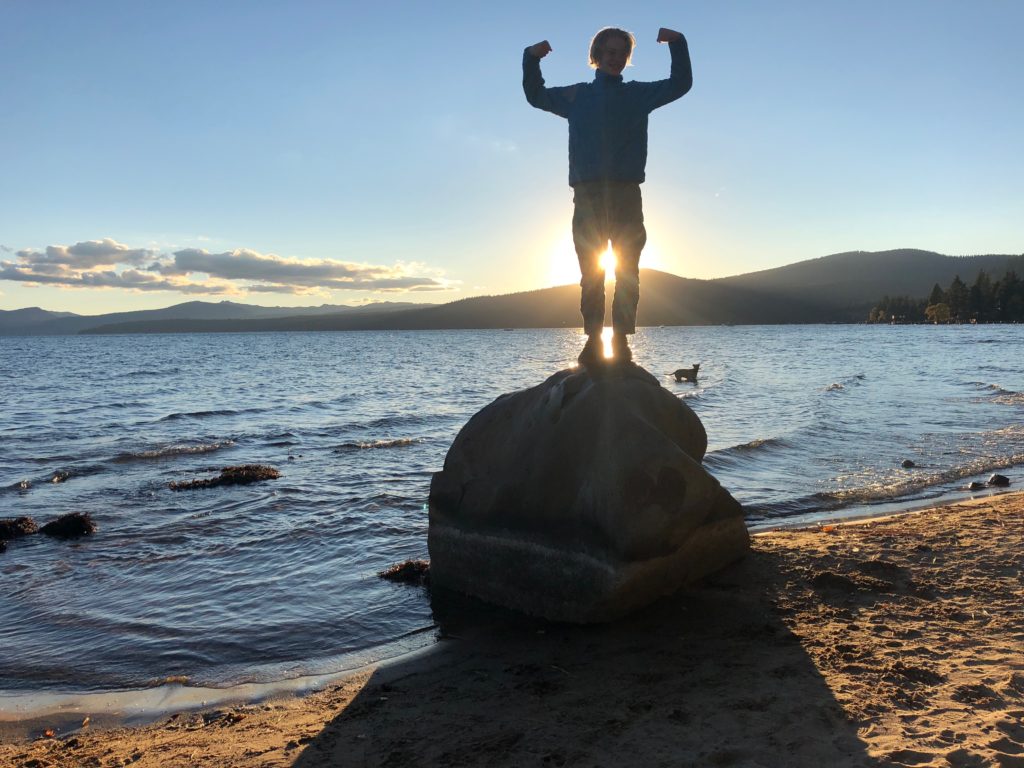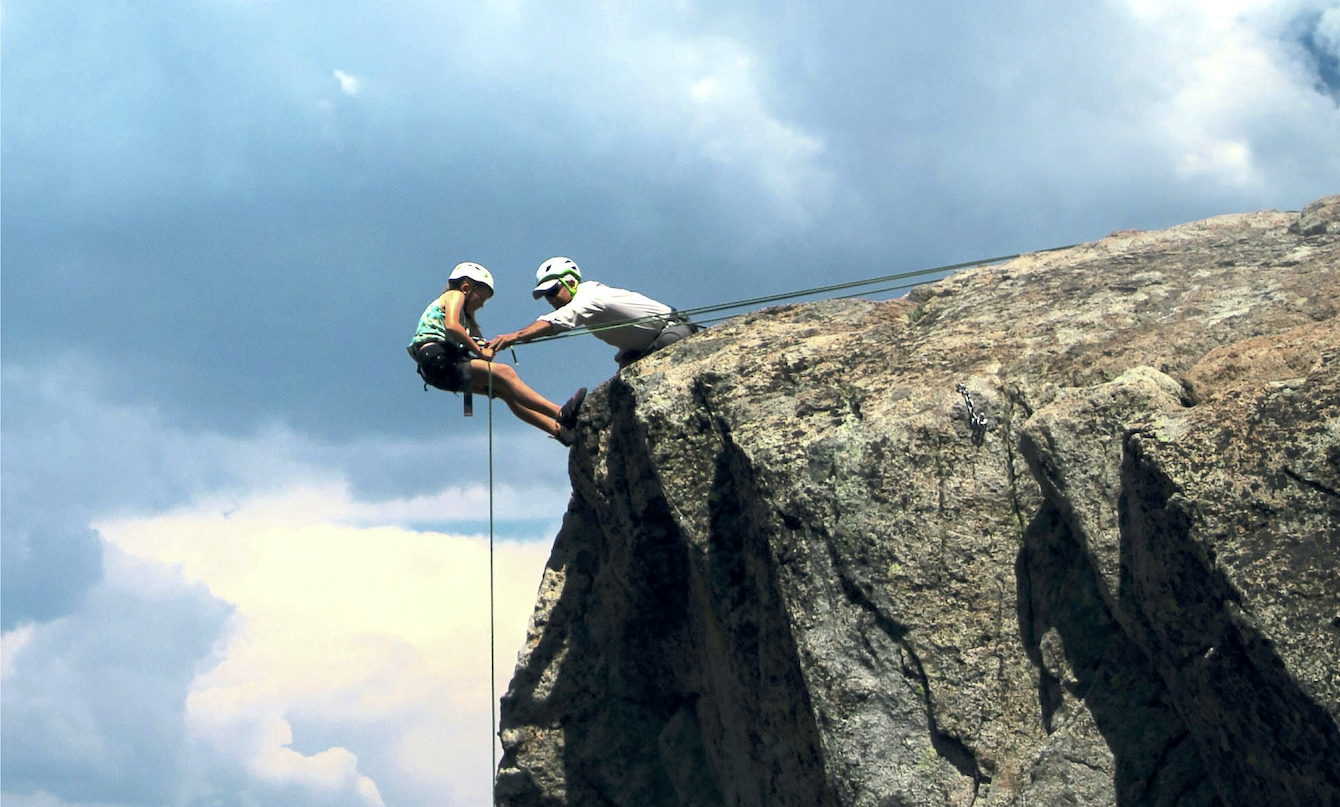Peter Mayfield is the founder and executive director of Gateway Mountain Center in California, an innovative program for helping youth learn, heal, and thrive.
As a teenager growing up in California, Peter became an accomplished rock climber, and developed into one of the world’s best mountain climbers, rising to become chief guide of the Yosemite Mountaineering School. Yosemite is known for being a rock climbing mecca, offering climbers some of the most difficult ascents anywhere in the world.
He has enjoyed a 40-year career guiding people in mountain experiences and developing entrepreneurial enterprises. He is the founder of City Rock, the first full-service climbing gym in the world.
Today, he is passionate about changing the system of care for youth suffering from serious emotional disturbances and complex trauma. Gateway’s program, ‘Whole Hearts, Minds and Bodies’ is the first nature-based therapeutic program in California to achieve full-service partner contracts with County behavioral health departments and certification as a MediCal provider. This means that California has recognized his nature-based therapeutic programs as providing a medical benefit.
In this interview, Peter speaks about his journey from mountaineering to his role as an educator and mentor, and how enabling children and adolescents to connect with nature has such a profound effect on their health and wellbeing.
The transcript below has been edited for length and clarity. Listen to the audio of the interview here.
James Moore: Peter, welcome, thank you for taking the time to chat with us at Mad in America. What was it that took you from your 40-year career as a mountaineer and guide to developing unique, nature-based therapy for troubled youngsters?
Peter Mayfield: I’m thrilled to be part of this community, I’ve learned a lot from Mad in America and its efforts, so very glad to be here.
I started my lifetime love affair with the mountains at an early age and by 15 years old I was a certified climbing leader for the Sierra Club. My transformation started with this intense feeling of the contrast. Each weekend I would be facilitating a transformational experience for people in the mountains when leading a climbing outing. Then I would return to being a high school student in San Francisco taking physical education class and some coach would be barking at me to run laps and do push-ups. I felt very strongly that we needed to evolve physical education to become a much more embodied and connected experience. So that became my goal, I told people “I want to do something to transform physical education in America“. So I went right into guiding and I worked at the largest climbing school in America, Yosemite Mountaineering School where I was chief guide. So I did have a successful career as a climber, but I was teaching and guiding the whole time.
What rock climbing does is provide this instantly deep immersion into what’s called a ‘flow state’ and it is somewhat unique as an activity because that happens even with the first step off the ground for a beginner. In any sport, once you have enough hours to get toward mastery, a successful participant learns how to drop into that flow state, that present moment experience where you are just being, not ruminating and thinking and pondering, you are just in the moment and that is very powerful. So I focussed on exploring that state in many different contexts, including corporate leadership events, with military training groups and increasingly with youth who had issues and challenges in their lives.
My first business 30 years ago was the first full-service rock climbing gym. We catered for all sorts of groups and sometimes kids from the adolescent drug treatment center would join us. I worked with a group that was supporting homeless teens and helping with recovery from heroin addiction and we just saw how this type of climbing experience really made an impact. We witnessed how climbing improved their sense of self, their self-efficacy and self-awareness. So for me, it has been a long-time engagement with these ideas and I would describe it as my life’s work.
Moore: You founded the Gateway Mountain Center, so I wanted to ask how that helps support children and adolescents in their struggles with mental health issues?
Mayfield: We are lucky to be in a spectacular and rugged location, up at the Sierra crest on the way to Lake Tahoe at an elevation of 7,100 feet. We partner with the Sierra Club and we make use of their lodge, so we can accommodate up to 145 youth. So naturally, we started with field trips. Groups of students, sixth grade through high school would come up with their teachers and stay with us for three or four days doing field science and mountain adventure.
Increasingly though we started to work on social, emotional skill building and resilience building through these mountain adventures. At the same time, we started doing programming for alternative education sites in our communities. We have a continuation high school and what used to be called a probation school which included youth who had previously been involved with law enforcement. This was around 13 years ago and as we did more and more therapeutic work, we began to see more and more youth who were on medication. We would get their medical forms for summer camps that are going to be seven days straight and the parents are loading us up with all the pill bottles.
This mirrored the increase in the number of youth diagnosed with ‘Attention Deficit Hyperactivity Disorder’ and after a couple of years, we are seeing something like half our kids are on these medications. I found that interesting because I have seen for myself how many of those kids found their way to the sport of rock climbing or rock climbing camps. I think back to the 1970s when I was young and I am glad that I got to be a creative, energetic kid and that I wasn’t labelled myself. So we started thinking that we should have focused programs to support these kids because they are finding us naturally. This was really on the upper-income level of the population we work with.
On the other hand, we are working in this probation school and we are seeing kids with serious emotional disturbances. Often these are the lower-income level and the kids are on Medicaid and MediCal. We are witnessing these kids who are depressed and suicidal, sometimes coming from a seriously adverse childhood background or a very challenging home life and we are seeing how long it took for them to get access to a therapist. We are also finding sporadic access to psychiatry, along with the unskilful application of medications.
In our California state system, there is a funding stream for mental health treatment called the Mental Health Service Act and about nine years ago they put a lot of emphasis on innovation. They were giving funding to support people trying new things and explicitly these monies could not be used for the existing system of care. We were invited to apply for funding because of our innovative work in the alternative education system. Right before our proposals were made, I read Robert Whitaker’s Anatomy of an Epidemic, and it had a big influence on me. I already had a strong opinion about ineffective mental health treatments in the United States for youth and reading that book matched with my own experience.
So then we were successful in securing funding and we were off and running, developing our initial program which was called ‘Whole Hearts, Minds and Bodies – Nature-based Therapeutic Mentoring’. What we didn’t anticipate though was that we would very quickly be given referrals to support some of the highest need youth in our communities. These are kids who have had multiple suicide attempts, multiple psychiatric hospitalizations and that could be said to be frequent flyers of the ‘5150’ which is the term for when a kid gets committed to a psychiatric facility for five to seven days. We had school psychologists saying to us “nothing else has worked, you’re piloting this program, why don’t you try with this kid?”
We had some spectacular early success which led us rapidly to where we are today. We went from a funded experiment to full-service partnership with a large County in about 18 months, which is just unheard of. We signed a contract before we even had an office, at the time we were still running it out of a little spare room in my house, so that’s the genesis of our program. It has really taken off and we are getting a lot of attention now as the ‘nature as medicine’ movement is really growing. We are, as far as we can tell, the first nature-based therapeutic program that is getting Medicaid reimbursement and these government contracts. We are partnered with the school of psychiatry at UC Davis, so the fourth-year residents have us as an elective rotation. The psychiatrist is picking a kid up from school and spending three hours with him and then he’s available to give parents some free counseling about medication. So in a sense, we have infiltrated the system of care to try to change it from within.

Moore: How did you go about getting the skills and experience within the team to be able to cover such a wide range of interventions for kids that might be struggling?
Mayfield: An entrepreneur’s primary role and skillset to develop is hiring great people. We have a key partner, Nancy Minges, who is a holistic health educator and we partnered with the Center for Adolescent Studies in Oakland, which is an amazing resource for trainings and certifications. We’ve hired several licensed Marriage and Family Therapists and so we are a fantastic internship location for people working toward their licensure. I think that we have hired well and then really made an effort to stay connected to the very forefront of trauma treatment theory and practice. I feel very committed to the Boston Trauma Center and we’re also looking at the Child Trauma Academy in Houston and the work of Dr. Bruce Perry along with the work of Dr. Bessel van der Kolk. We are being informed by these schools and by what we see in practice and using that to come up with our methods. So to answer your question, we’ve made a great effort to study and connect to what we feel is the best that is out there to develop our methods.
We are not a wilderness therapy program, so kids are not sent away to attend. Instead, we are treating them where they are. We pick them up from their school, spend three or four hours in a session involving nature and we often buy them dinner and take them home and then do it again the next week. So our service delivery is in the same rhythm as somebody getting weekly therapy. We are a nature-based, therapeutic program that can be woven into the youth’s normal life. They’re still in their family, they are still in school and still in their community. This is the game-changing aspect of what we do.
Moore: If a youngster comes to you and they have already internalized messages such as “I’m broken, I have this diagnosis and I have a broken brain” do you challenge those things directly or do you allow nature to infiltrate the way that the young person thinks about themselves?
Mayfield: I loved how you framed that question because for these kids that is their context, they are diagnosed and they are medicated. It takes a lot of skill and I use the term infiltrated because we support the family as we support the youth. No matter how well-meaning the practitioners are, that child has this message that something is wrong with them, so some of it is educating the parents. We do this carefully and sensitively because we want to be part of a movement where medication would be used less often and for less duration and more skillfully. I do distribute an essay that is posted on Mad in America from Dr. Sami Timimi, it’s a fantastic essay for parents considering medication. And I quote from that, we should look at it as a short term intervention, like if the kid broke their wrist and we put a cast on. The healing has to happen from within. I’ll sometimes tell people, “Attention Deficit Disorder, we call it Multiple Attention Ability” and it is a familiar skillset that mountain guides and entrepreneurs use to see the big picture and connect the dots. So we help kids find the strength-based framework and that is the healing path.
Our method we call ‘Four Roots for Growing a Human’. Root number one is authentic relationship. A core tenet of authentic relationship is that these kids come in and they’ve been given this messaging that they are broken or that we are going to fix them or that we are going to make this behaviour change in them. Our framework is that here you are and we’re going to connect and we’re going to develop a real therapeutic bond and we are not going to fix you, you have to fix yourself, you have to choose to change and grow. We hold that this therapeutic relationship can be like a mirror in which the youth grows their self-awareness and with growing self-awareness, kids tend to start making decisions they don’t regret. That’s it, that’s the framework and the beauty of our method is with three hours of engaging and sharing outdoor experiences, that relationship goes deep compared to 50 minutes on a couch.
We collaborate with all sorts of therapists and we love therapists but again so much of it is context. I’ll give you this stark example. In our community, services are centered in a county building called the Joseph Center. Let’s talk about a typical case we have, so maybe a youth who was exposed to drugs in utero and had a couple of foster placements but now they’re back with their family and their parents are sober, but they’ve been through a lot. So Mom, who is kind of stressed out working two jobs, will take time off work and take her son to the Joseph Center. They go inside, on the left is the court, on the right is the sheriff. They go up to the second floor and there is child protective services and probation. They go to the third floor and there is a wonderful therapist in a windowless room, but just going up those stairs is like a retraumatizing for the Mom and the kid. Is that a healing context going past all the law enforcement, all the County agencies that have threatened to take the kid away or did take them away?
 You contrast that to someone like myself picking that boy up from school with a kayak on my car. And he will say “Hey Peter, what are we doing today?” And I will reply “well, are you up for a challenge today? The wind is blowing so strong, I think we can paddle up Donner Lake as far as we can to surf some waves on the way back?” Then we’re sitting on the beach a couple of hours later and he’s really sharing some hard stuff that happened, maybe the fight he got into at school that got him suspended last week. All sorts of drama and therapy are happening. But what’s also happening is he’s developing this self-confidence, what we call going through embodied peak experience.
You contrast that to someone like myself picking that boy up from school with a kayak on my car. And he will say “Hey Peter, what are we doing today?” And I will reply “well, are you up for a challenge today? The wind is blowing so strong, I think we can paddle up Donner Lake as far as we can to surf some waves on the way back?” Then we’re sitting on the beach a couple of hours later and he’s really sharing some hard stuff that happened, maybe the fight he got into at school that got him suspended last week. All sorts of drama and therapy are happening. But what’s also happening is he’s developing this self-confidence, what we call going through embodied peak experience.
Just like he was challenging his balance paddling on the windy Lake. There is growing research that those inputs, that activation of the vestibular and the proprioceptive and the sensory-motor will strengthen his sense of self and that is actually healing. The medication he is on might keep him a little bit calmer, but it’s not going to heal him. This type of work will heal him, he will grow self-confidence, self-efficacy, self-awareness. In the relational experience he has an adult who is really there for him, a mentor, a coach telling him the truth. For a kid who has had a lot of emotional disturbance and family instability, that is key. Human beings need that.
Moore: You mentioned in some of your successes that very quickly you will see a child start to walk differently, they’ll start to carry themselves differently. That was such a beautiful mental image to have that the young person’s self-confidence was coming out even in the way they move.
Mayfield: We really do see that and I want to emphasize that the majority of the youth who we are working with are not athletic. A paper came out last year detailing the negative impacts on kids’ metabolism due to the common use of antipsychotics which essentially makes kids prediabetic rapidly. So it is common for us to have kids who are very overweight. They are not athletic and so we are looking for that embodied peak experience on relatively flat ground. I tell my team we’re looking for the rock climbing horizontally and that you can do that almost anywhere. So we are looking for the log across the Creek, the rock piles, the snowshoeing and deeper snow. Kayaking on a windy day does that too. Anything that drops them into the flow state, that place where they’re not thinking, they are doing, they are being, in their present moment.
Dr Ruth Lanius, a neuroscientist up in Western Ontario University, has done many brain scans on adults who experienced serious childhood trauma, complex trauma or developmental trauma disorder. The scans are showing consistent signatures where there are weak connections in parts of the default mode network and there’s a growing theory that this consistent repetitive activation of the vestibular sensory-motor proprioceptive neurologic structures can strengthen those weak connections. We see that. We’ll have kids who come into our program, we start treating them and their posture is kind of submissive and worn out and beat by the world. They are shuffling their feet and not looking you in the eye. After a few months of these weekly sessions they are holding their head up, they are walking with confidence, their balance skills have improved and that strongly correlates with behavioral change. Their ability to regulate emotionally, their ability to face setbacks and challenges, their relationships with their families and their ability to get through the school day.
Moore: It must be quite something to witness a child turn their attention from being very inwardly-focused and wondering what’s wrong with them to connecting and turning their focus out to the nature and the world around them and to put their faith in you. I wondered how that makes you feel when you experience that?
Mayfield: I have been a guide for 40 years, so it is a familiar feeling for me. For my staff, there are 18 therapeutic mentors, they really love this work and part of it is we don’t burn them out. We want it to be a part-time, highly trained, highly supported, well-paid job. These people are working with two or three kids, devoting a few afternoons a week to this work. They love it and seeing the change in the kids and having that relationship is amazing. Another hallmark is that we’re a lot less ‘boundaried’ than the typical therapists. So we do get to know these families. We’re bringing the kid home after dark and they don’t just jump out of our car, we go into the living room and talk to the families. A lot of the wounding that happens with kids who have serious emotional disturbances is disconnection from their families or they are wearing out their families or there is a lot of drama and we are there for the kids, but we are actually added capacity so we can give more family support too.
We also have a full-time social worker in-house now so that we can help with education. That is useful for parents when supporting a kid like this. We often end up getting invited to the younger sister’s Quinceanera, or family picnics and we’re also there in the middle of the night when something bad happens. We will go to the probation meeting and we’ll show up at the hospital. It’s very meaningful to be able to have that. Not just be like we’re going to clinic nine to five and it goes to an answering service if you have a problem on the weekend or at night. I would just say we have a more intimate connection to the whole family. That’s very meaningful.
Moore: That theme of connection seems to run as a central philosophy through a great deal of what you do. I was interested to read your blog about the ‘life force’, that struck me as quite powerful, how do you communicate that to the kids?
Mayfield: I would say the skillful way is to not explain but to get on your hands and knees with a young person and really look at that anthill and look at the leaf that the butterfly just flew away from. We evolved to be skilled at taking in the information from the incredibly rich sensorium of nature, that is how our brains adapted. It is so healthy to engage those structures in our brains and to be exposed to that. In the springtime, we put on waders and we go out in this lake and search for toad eggs and it’s amazing to wade around in half a meter of water and see mating toads and find big strings of toad eggs, then come back three weeks later and see little tadpoles. I’m a grandfather and nothing is more rich and fun than rooting around on the forest floor with my two-year-old granddaughter or my five-year-old grandson. What has happened in our society is that maybe they do a field trip in sixth grade when they’re 11 or 12, and then it stops. So when you can take a 16-year-old who has had all this challenge and difficulty and trauma and being traumatized by the system and you can get back to that joyful place they were at as a five-year-old, it is healing.
Moore: As a society, we have probably inflated the gravity of mental health problems so much that we’ve probably then underplayed the value and the power of relatively simple natural ways of connecting and dealing with those difficulties.
Mayfield: We are always triaging a waitlist and that is the hardest part of this work, taking calls from parents who are really under stress in supporting their youngsters. Our service is reserved for the most serious cases, so maybe those kids who have had a hospitalization or been arrested or some kind of meltdown that was so serious that an intervention absolutely has to happen. But I do get a lot of calls from parents with kids who have normal teenage issues and they all want to be in our program. The counsel I give over the phone to these parents is to imagine how we all lived a few thousand years ago. We were in these bands of 45 to 60 people, deeply interdependent and interconnected and the adolescent brain evolved to be really good at connecting to other adults. There wasn’t this isolated nuclear family back then. Adolescents are so hungry to connect, so a lot of my advice for these parents is the kid has to find what they can be passionate about but just help them, help expose them to all these opportunities to connect with other cool adults. The best parents in the world are not enough. Adolescents are hungry to connect to get into creative programs or sports programs, but also let them have free time. So it’s connecting to nature, but also connecting to each other. Adolescents connecting to great adults who can give them support.
Moore: What you are doing is so important because not only are you attending to the growing problem of mental distress in youth, but you are also sowing the seeds for the generation that are going to have to take on climate change and do something about it.
 Mayfield: It is so true, the kids going through our therapeutic method are also becoming more environmentally literate and that is a good thing. It is meaningful and we love this hugely growing youth movement about climate change and social activism too. So back to our four roots methods. Root number four is helping others. Some of it’s a trajectory of age. For example the 10-year-old, we will get them volunteering a little bit. But the 16-year-old when she says “hey, I need to start looking for a job, can you give me some coaching about that?” and we set her up with a really cool volunteer gig, all of a sudden she goes from being the problem child to being a helper. And that is hugely healing having these kids connecting to the community through service.
Mayfield: It is so true, the kids going through our therapeutic method are also becoming more environmentally literate and that is a good thing. It is meaningful and we love this hugely growing youth movement about climate change and social activism too. So back to our four roots methods. Root number four is helping others. Some of it’s a trajectory of age. For example the 10-year-old, we will get them volunteering a little bit. But the 16-year-old when she says “hey, I need to start looking for a job, can you give me some coaching about that?” and we set her up with a really cool volunteer gig, all of a sudden she goes from being the problem child to being a helper. And that is hugely healing having these kids connecting to the community through service.
Adolescents want to have meaning in their life and to be part of something bigger. We all want that because we are all suffering from the huge, illogic disconnect between how our societies have organized our material existence and our relationship with the planet. Now I help kids get excited about future opportunities. I think this young generation gets to redesign everything about our material existence, how we do transportation and energy and food and housing. So to me, it presents an exciting opportunity but you can also see how fear of the future can contribute to the global increase in depression.
One thing that’s very interesting about our method is it’s a very efficient delivery system. I think that’s important. We built a system where one licensed therapist can clinically supervise five therapeutic mentors who are each treating two or three youth. So one licensed therapist is overseeing some 80 hours of nature-based therapeutic mentoring for the highest need youth. So it is a very effective delivery system and we are ambitious, we think this method should spread. We are hoping to prove this in some other locations and then really maybe to license the method in a much bigger context like to a large healthcare company. So we’re very excited about it. We think it is a potential model that that is worth spreading.
Moore: Hearing about your work does give me hope for the future that we can encourage the next generation to deal with some pretty significant challenges in their lives. I hope that the method that you’ve pioneered is spread all over the world is as quickly as possible because we desperately need it.
Mayfield: Thank you very much and as I said it means so much to me to be part of the Mad in America community. It’s a great service that you have created to spread great knowledge.
Moore: I want to thank Peter for taking the time to chat and if you’d like to know more about the work of the Gateway Mountain Center, you can visit the website www.sierraexperience.org

****
MIA Reports are supported, in part, by a grant from the Open Society Foundations





Thank you James and Peter.
These ARE the ONLY therapies that work. For kids and adults.
It also helps to “heal” the psychiatrist to some degree so he doesn’t get entrenched in linear thinking.
Society wastes endless dollars in keeping bad systems going and keeping us there.
It is up to politicians to help, once they get some guts to address the issues of blaming and false treatments.
Wonderful work you are doing, PLUS, you enjoy it. I doubt too many psychiatrists get any real life satisfaction from their jobs, not in that fuzzy warm feeling.
It is rather sad for psychiatrists and is something they refuse to acknowledge and talk about.
Psychiatry suffers under it’s own falsities. Their unhappiness is transferred to the client and society.
It is this big wheel of dysfunction.
My son works in a small government funded school, 12 clients per year, and his job includes picking the kids up, finding out what they want to do, perhaps skateboarding, shopping, hoops, swimming. And within the curriculum, he helps them with that work. There are no hard and fast rules for these kids and they stay in that environment for 2-4 years, due to underfunding.
Ideally, it would identify kids early and stick them into environments that stimulate interest, success, pride, self knowledge, resilience to failures.
Keep going and expand.
Lobby. Speak out.
We need our kids saved from the clutches of psychiatry. We need them saved from the environments they are in without removing them even from their “dysfunctional” households.
We need to redirect focus on community, having somewhere that everyone gets a feeling of belonging.
Psychiatry has that belonging within their own elite group, yet refuses to provide it to innocent victims.
Report comment
This! ❤️
Report comment
I don’t have to read this!
If I could shut down the current mental health system and replace it with something, it would be trips into nature! Honestly. Environment is a key player in health—and more! “All is good in nature.” We know this without even second guessing it.
Report comment
I love this so much. I’m going to apply to work for y’all 🙂
Report comment